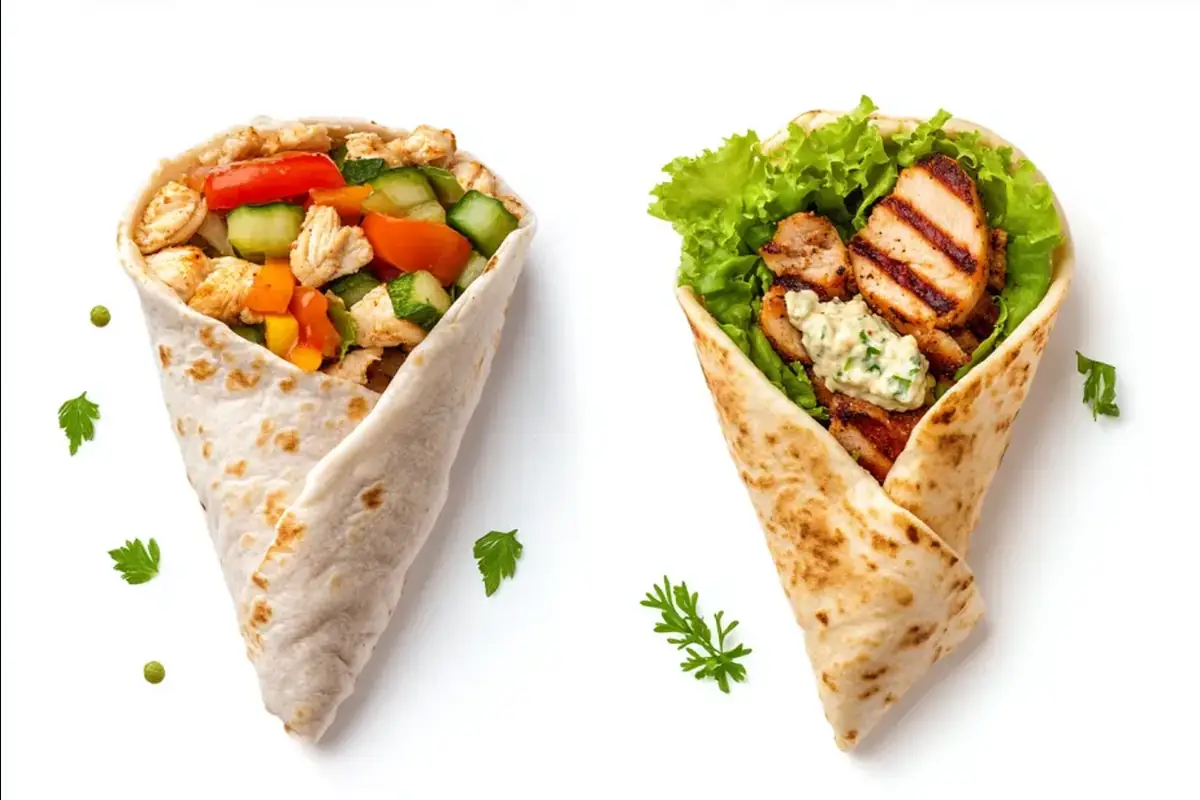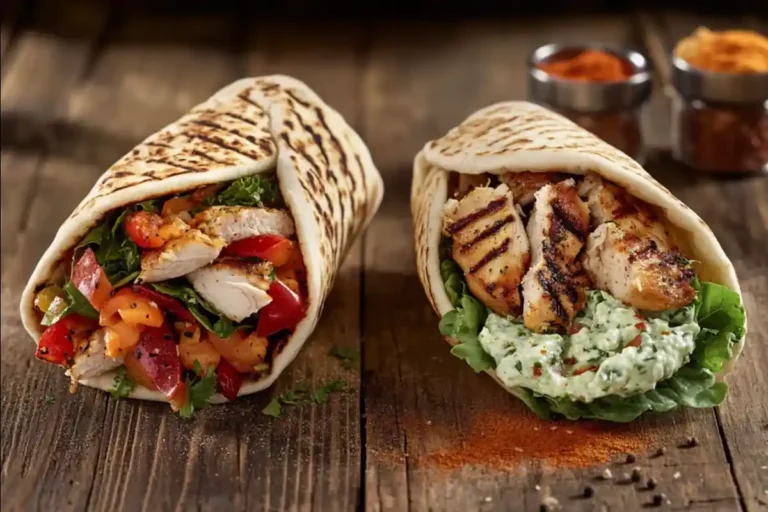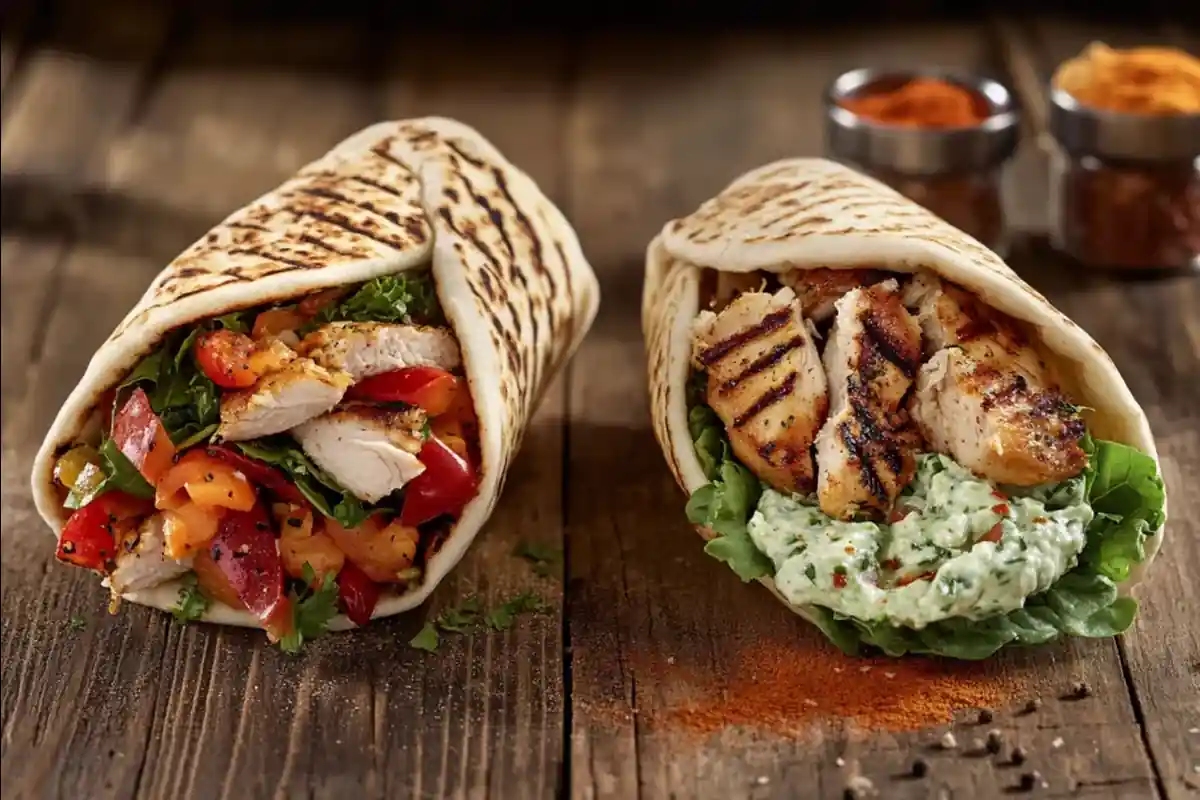1: Introduction
Difference Between Chicken Gyro and Chicken Pita
Mediterranean cuisine is beloved for its fresh ingredients, bold flavors, and vibrant cultural heritage. Among its most popular dishes, the chicken gyro and the chicken pita stand out as fan favorites. Both have roots in Mediterranean culinary traditions, but their differences often leave food lovers curious.
To clear up the confusion, we’ll explore the difference between chicken gyro and chicken pita, examining their preparation, ingredients, origins, and cultural significance. Understanding the difference between chicken gyro and chicken pita will help you appreciate each dish’s unique qualities. By understanding these distinctions, you’ll better appreciate the unique qualities of each dish and know when to choose one over the other.
In this article, we’ll dive deep into their history, flavor profiles, visual presentation, and even nutritional insights. If you’ve ever wondered, “What’s the difference between chicken gyro and chicken pita?” or found yourself debating between the two at a restaurant, this guide is for you.
2: Origins and Cultural Background
2.1 Chicken Gyro: A Greek Icon with Turkish Influences
The chicken gyro originates from Greek cuisine but has clear influences from Turkish cooking traditions, particularly the döner kebab. The word “gyro” comes from the Greek word “gyros,” meaning “turn,” which describes how the meat is cooked on a vertical rotisserie. This method of cooking, introduced to Greece in the 1920s by Turkish immigrants, became a defining feature of the gyro.
Gyros are now synonymous with Greek street food and are a staple of Mediterranean dining. Typically, the meat is marinated with Mediterranean herbs and spices, slowly cooked to perfection, and thinly sliced off the rotating spit. Gyros are traditionally wrapped in pita bread and served with tzatziki sauce, tomatoes, and onions.
In Greece, chicken gyros are celebrated for their smoky flavor, making them a must-try for anyone exploring the country’s vibrant culinary scene. While traditionally made with pork or lamb, chicken gyros offer a lighter alternative. Exploring the difference between chicken gyro and chicken pita highlights how these dishes cater to modern health-conscious eaters.
2.2 Chicken Pita: A Versatile Mediterranean Favorite
Unlike the gyro, the chicken pita isn’t tied to one specific country or cooking method. It has a broader Mediterranean origin and is more versatile in its preparation and presentation. While gyros are closely associated with Greek cuisine, pita sandwiches featuring chicken can be found across the Middle East, North Africa, and beyond.
The beauty of the chicken pita lies in its adaptability. Whether filled with grilled chicken souvlaki, roasted chicken, or even leftovers, the dish allows for an endless combination of ingredients and sauces. Depending on the region, you might find a chicken pita stuffed with hummus, tahini, pickled vegetables, or an assortment of fresh greens.
Globally, the chicken pita has become a canvas for culinary creativity. From casual takeout joints in New York to upscale Mediterranean restaurants in London, chefs around the world have put their spin on this iconic dish.
The historical significance of both dishes adds to their appeal, but exploring the difference between chicken gyro and chicken pita reveals how their unique preparations and flavors cater to diverse tastes. Next, we’ll explore how these dishes differ in terms of ingredients and preparation.
3: Ingredients and Preparation
3.1 Meat and Cooking Styles
One of the most noticeable distinctions when understanding the difference between chicken gyro and chicken pita lies in how the chicken is cooked.

Chicken Gyro:
The meat in a chicken gyro is cooked on a vertical rotisserie, which gives it a unique flavor and texture. Before cooking, the chicken is marinated in a blend of Mediterranean spices, typically including garlic, oregano, thyme, paprika, and lemon juice. As the meat rotates, the outer layer caramelizes beautifully, adding a smoky and slightly crispy texture.
The slow-cooking process ensures the chicken stays tender and juicy. Once done, the meat is shaved into thin slices, ideal for layering in a pita wrap with fresh toppings.
Chicken Pita:
In contrast, the chicken in a pita sandwich is more flexible in its preparation. It might be grilled, skewered (as in souvlaki), or even roasted. For example, Greek chicken souvlaki features marinated chicken pieces cooked on skewers over an open flame, creating a smoky yet slightly charred flavor.
Because there’s no standard method of cooking, chicken in pita sandwiches can vary widely in flavor and texture depending on the preparation style. This versatility makes chicken pita an excellent choice for people with different taste preferences, further emphasizing the difference between chicken gyro and chicken pita in terms of flavor and adaptability.
3.2 Bread and Fillings
Both dishes feature pita bread, but the way people use it sets them apart.
Chicken Gyro:
For gyros, the pita bread is usually warm, fluffy, and slightly toasted. The bread acts as a wrap, holding all the ingredients together in a portable format. This allows for easy handling, making gyros a popular street food choice.
Chicken Pita:
In chicken pita sandwiches, the bread often forms a pocket, with a cut opening used to stuff it with ingredients. This pocket-style presentation allows for more variety in fillings and toppings, making it a customizable option.
3.3 Common Toppings
Chicken Gyro Toppings:
The toppings for chicken gyros are relatively standard. Most gyros include:
- Tzatziki sauce (a creamy, tangy yogurt-based sauce with cucumber and garlic).
- Sliced tomatoes.
- Sliced onions.
These ingredients complement the smoky flavor of the meat, creating a balanced taste.
Chicken Pita Toppings:
Chicken pita sandwiches, on the other hand, offer more flexibility. Depending on the region or the chef’s creativity, toppings might include:
- Hummus or tahini for a nutty flavor.
- Pickled vegetables for a tangy kick.
- Sautéed or fresh greens for added texture.
- Spicy sauces or chili oil for heat.
While the foundational ingredients are similar, the differences in preparation and toppings allow each dish to stand out. In the next section, we’ll focus on the key differences between chicken gyros and chicken pitas.
4: Difference Between Chicken Gyro and Chicken Pita
4.1 Cooking Techniques
The difference between chicken gyro and chicken pita starts with their cooking techniques, which significantly influence their overall taste and texture.
Chicken Gyro:
The vertical rotisserie method used for gyros creates a unique flavor profile. As the chicken rotates and cooks, it develops a lightly charred exterior while retaining its juiciness on the inside. This technique produces tender slices of meat with a smoky, caramelized edge.
Chicken Pita:
With chicken pita, the cooking technique depends on the recipe or regional tradition. Grilling, roasting, or skewering are the most common methods, each offering its own twist on flavor. For example, grilled chicken delivers a smoky aroma, while roasted chicken offers a slightly sweeter, caramelized taste.
4.2 Flavor Profiles
The seasoning and preparation of each dish also contribute to their distinctive flavors.
Chicken Gyro:
Chicken gyros often feature bold, robust spices like oregano, garlic, and paprika. The rotisserie cooking process further enhances these flavors, creating a smoky and savory taste that pairs well with cool, tangy tzatziki sauce.
Chicken Pita:
Chicken pita sandwiches are more adaptable in terms of flavor. The seasoning might be mild or heavily spiced, depending on the intended cuisine. For instance, Middle Eastern-style chicken pitas often include warm spices like cumin and coriander, while Greek versions may lean toward fresh herbs like dill and parsley.
4.3 Cultural Context and Adaptations
The cultural significance of each dish is another important distinction.
Chicken Gyro:
Greek culture deeply roots gyros, making them a staple of Greek street food. Over time, they gained international recognition and became a favorite in countries like the United States, where vendors often adapt them with local flavors.
Chicken Pita:
Chicken pita sandwiches have a much broader Mediterranean appeal, with delicious variations found in Middle Eastern, North African, and even Indian cuisines. Additionally, this versatility has undeniably made the chicken pita a global phenomenon, as each region creatively adds its unique twist to the dish.For example, a pita in Lebanon might feature garlic sauce and pickled turnips, while one in Morocco could include harissa and roasted peppers.
The difference between chicken gyro and chicken pita is deeply rooted in their cooking techniques, flavor profiles, and cultural contexts, making each dish uniquely appealing. Up next, we’ll examine their nutritional aspects to help you make an informed choice.
5: Nutritional Insights
5.1 Calorie and Macronutrient Breakdown
When it comes to nutrition, the chicken gyro and the chicken pita offer different benefits based on their preparation methods and ingredients.
Chicken Gyro:
A standard chicken gyro is typically lower in calories compared to other fast-food options, thanks to the lean protein used in the chicken. However, the calorie count can vary depending on the portion size and additional toppings like tzatziki or cheese.
- Calories: Approximately 400–600 per serving (with pita and toppings).
- Protein: High protein content, ranging from 20–30 grams.
- Fats: Moderate, mainly from the marinade and tzatziki sauce.
- Carbohydrates: Moderate, primarily from the pita bread.
The combination of lean meat and fresh toppings makes chicken gyros a popular choice for those seeking a balanced meal with bold flavors.
Chicken Pita:
Chicken pitas are more variable in terms of nutrition, depending on the ingredients. For instance, a pita stuffed with grilled chicken, fresh vegetables, and hummus might have fewer calories than one loaded with fried chicken and creamy sauces.
- Calories: 350–700 per serving, depending on toppings and sauces.
- Protein: Comparable to a chicken gyro, with 20–30 grams per serving.
- Fats: May vary widely based on the choice of sauces (e.g., tahini, garlic sauce).
- Carbohydrates: Moderate, similar to the chicken gyro.
5.2 Health Benefits and Considerations
Both dishes have their health advantages, but there are some points to consider based on your dietary goals:
Chicken Gyro Benefits:
- The vertical rotisserie method minimizes added fats, making it a leaner option.
- High protein content supports muscle maintenance and energy.
- Tzatziki sauce, made from yogurt, is a healthier condiment compared to mayonnaise-based sauces.
Chicken Pita Benefits:
- Greater variety in vegetables and toppings can increase the nutritional value.
- Pita bread pockets allow for portion control and customization.
- The ability to use grilled or roasted chicken reduces unhealthy fats.
Health Considerations:
- Gyros often include sodium-heavy marinades, which may not be ideal for individuals monitoring their salt intake.
- Chicken pitas can be higher in calories if loaded with creamy sauces or fried chicken.
Nutritionally, both dishes have their strengths and can fit into a balanced diet when made with wholesome ingredients. Let’s now explore how these dishes look and are presented visually to highlight their appeal.
6: Visual Presentation
6.1 How is Chicken Gyro Different from Chicken Pita in Appearance
The presentation of food can significantly influence our perception of its taste and appeal. Both the chicken gyro and the chicken pita have distinct visual styles that reflect their cultural origins and preparation methods.

Chicken Gyro:
A chicken gyro typically has a beautifully layered, rustic appearance. The cook slices the meat thinly from the rotisserie and stacks it neatly in the pita wrap, often slightly toasting or charring the bread for added flavor. Additionally, vibrant toppings like red tomatoes, white tzatziki sauce, and golden caramelized onions come together to create a visually appetizing combination.
Moreover, gyros often appear as a portable, compact meal that’s incredibly easy to eat on the go. In fact, the sight of the juices dripping from the meat, paired with the contrast of colors between the ingredients, makes it almost irresistible.
Chicken Pita:
Chicken pitas generally feature a neat, pocket-like presentation, with chefs slicing open the pita bread and filling it with ingredients. The fillings are usually visible from the top, showcasing the vibrant colors of the chicken, vegetables, and sauces.
Depending on the recipe, chicken pitas might include garnishes like parsley or paprika, adding a touch of elegance. This structured presentation makes them perfect for serving in both casual and formal settings.
7: Cultural and Regional Variations
7.1 Regional Interpretations Gyro vs Chicken pita
The chicken gyro and chicken pita have traveled far from their Mediterranean roots, taking on unique variations in different parts of the world. These regional adaptations not only highlight the versatility of both dishes but also showcase the difference between chicken gyro and chicken pita across various cuisines.
Chicken Gyro in Greece and Beyond:
In Greece, the chicken gyro remains a cherished and traditional street food. Typically, vendors prepare it with homemade tzatziki sauce, freshly baked pita, and locally sourced vegetables. Furthermore, the emphasis is always on simplicity and authenticity, ensuring that every ingredient reflects the region’s rich culinary heritage.
In the United States, chicken gyros have been adapted to cater to local tastes. For example, you may find variations with ranch dressing instead of tzatziki or with added cheese. Some restaurants even offer a “gyro bowl,” where the meat and toppings are served over rice instead of in pita bread.
Chicken Pita Across the Mediterranean:
While chicken pitas are common in Greece, their variations across the Middle East and North Africa are equally noteworthy. In Lebanon, for instance, chicken pitas often feature garlic sauce (toum) and pickled vegetables, creating a tangy, garlicky flavor profile.
In Morocco, chicken pita fillings might include spiced chicken with harissa, a chili paste that adds heat and depth to the dish. Meanwhile, in Turkey, pita sandwiches might feature grilled chicken with yogurt-based sauces and a sprinkle of sumac for a citrusy kick.
7.2 International Adaptations: Chiken pita and Chicken gyro comparison:
Both dishes have become global favorites, with chefs and home cooks experimenting with fusion recipes.
Chicken Gyro:
In fusion cuisine, chicken gyros are sometimes reinvented with international ingredients. For example, in Japan, you might find gyros with teriyaki-marinated chicken, while in Mexico, a “gyro taco” might feature spiced meat in a tortilla.
Chicken Pita:
Chicken pitas have an even broader range of adaptations. In India, for instance, chicken tandoori pitas combine grilled chicken with a yogurt-based marinade and spicy chutney. In Western countries, chicken pitas are often filled with salad greens, avocado, or even bacon, catering to local palates.
The cultural and regional diversity of the chicken gyro and chicken pita underscores their universal appeal. Now, let’s address common questions to further clarify the distinctions between these beloved dishes.
8: FAQs about Gyro vs. chicken pita
Is chicken gyro pita healthy?
Both chicken gyros and chicken pitas can offer health benefits, depending on their preparation. Chicken is a lean source of protein, and when paired with fresh vegetables and whole-grain pita bread, these dishes provide a balanced meal. However, watch out for high-calorie sauces like tzatziki or garlic sauce, as well as portion sizes. Opting for grilled or roasted chicken can also reduce fat content.
What is chicken gyro made of?
A chicken gyro typically consists of marinated chicken cooked on a vertical rotisserie. Chefs thinly slice the meat and serve it in a warm pita wrap with toppings like tzatziki sauce, tomatoes, onions, and sometimes fries. The marinade often includes garlic, oregano, paprika, lemon juice, and olive oil, creating a bold Mediterranean flavor.
What is the difference between Greek and regular pita bread?
Greek pita bread is usually softer and thicker compared to regular pita bread, which is thinner and often used to make pocket-style sandwiches. Greek pita is ideal for wraps, as it doesn’t tear as easily and provides a more substantial base for fillings like chicken gyros. Regular pita bread, on the other hand, is perfect for stuffing with ingredients, as its pocket can hold a variety of toppings.
Can you substitute one for the other in recipes?
While both dishes share similarities, understanding the difference between chicken gyro and chicken pita will help you make the right choice. For instance, the smoky flavor of chicken gyro complements tzatziki-based dishes, while the versatility of chicken pita works well with a wider variety of fillings and sauces.
9: Conclusion
The difference between chicken gyro and chicken pita lies not only in their preparation methods but also in their flavor profiles and cultural contexts, ultimately highlighting the uniqueness of these Mediterranean favorites. For instance, chicken gyros have deep roots in Greek tradition, featuring marinated, rotisserie-cooked chicken served in a wrap with tzatziki, onions, and tomatoes. Moreover, their smoky, bold flavor and portable presentation further make them a quintessential street food.
In contrast, chicken pitas are more versatile, with global interpretations and a wide range of preparation styles. Highlighting the difference between chicken gyro and chicken pita, this adaptability makes the chicken pita a favorite for those seeking customizable options.
Print
What’s the difference between chicken gyro and chicken pita?
Discover the flavorful difference between Chicken Gyro and Chicken Pita with this step-by-step guide. Chicken Gyro features marinated chicken cooked on a vertical rotisserie, while Chicken Pita typically involves grilled chicken stuffed into a pita bread. Both recipes are Mediterranean favorites, perfect for lunch or dinner, and are customizable with fresh vegetables, tzatziki sauce, and toppings. Learn how to prepare each dish and choose your favorite!
- Total Time: 2 hours 20 minutes (Gyro), 1 hour 5 minutes (Pita)
- Yield: 4 servings
Ingredients
For Chicken Gyro
- 1 lb (450 g) boneless, skinless chicken thighs
- 3 tbsp olive oil
- 2 tbsp Greek yogurt
- 2 tbsp lemon juice
- 3 cloves garlic, minced
- 1 tsp dried oregano
- 1 tsp ground cumin
- 1 tsp smoked paprika
- ½ tsp ground coriander
- Salt and pepper to taste
For Chicken Pita
- 1 lb (450 g) boneless, skinless chicken breast, cut into strips
- 2 tbsp olive oil
- 2 tbsp lemon juice
- 2 cloves garlic, minced
- 1 tsp dried oregano
- ½ tsp paprika
- Salt and pepper to taste
Common Toppings and Accompaniments
- 4 pita breads
- 1 cup tzatziki sauce
- 1 cup diced tomatoes
- ½ cup sliced red onions
- 1 cup shredded lettuce
- ½ cup crumbled feta cheese (optional)
Instructions
Chicken Gyro
- Prepare Marinade: In a bowl, combine olive oil, Greek yogurt, lemon juice, minced garlic, oregano, cumin, smoked paprika, coriander, salt, and pepper. Mix well.
- Marinate Chicken: Add chicken thighs to the marinade, ensuring they are fully coated. Cover and refrigerate for at least 2 hours, preferably overnight.
- Cook Chicken: Preheat a grill or skillet over medium heat. Cook the marinated chicken until browned and cooked through (internal temperature of 165°F/75°C), about 5-7 minutes per side. Slice thinly.
- Assemble Gyro: Layer pita bread with tzatziki sauce, sliced chicken, tomatoes, onions, lettuce, and optional feta cheese. Roll and serve.
Chicken Pita
- Prepare Marinade: In a bowl, mix olive oil, lemon juice, minced garlic, oregano, paprika, salt, and pepper.
- Marinate Chicken: Add chicken strips to the marinade. Cover and let sit for 30 minutes to 1 hour.
- Cook Chicken: Heat a skillet or grill pan over medium-high heat. Cook chicken strips until golden and fully cooked, about 3-4 minutes per side.
- Assemble Pita: Place chicken strips into a pita bread. Add tzatziki sauce, diced tomatoes, onions, lettuce, and optional feta. Fold and serve warm.
Notes
- Use store-bought tzatziki for convenience, or make your own with Greek yogurt, cucumber, garlic, and dill.
- Chicken Gyro is traditionally cooked on a vertical rotisserie, but a grill or skillet works well for home cooking.
- Chicken Pita is faster to prepare, making it ideal for a quick weeknight meal.
- Prep Time: 15 minutes
- Cook Time: 2 hours (Gyro), 30 minutes (Pita)
- Category: Main Course, Wraps, Sandwiches
- Method: Grilling, Skillet
- Cuisine: Mediterranean, Greek


1 thought on “What’s the difference between chicken gyro and chicken pita?”